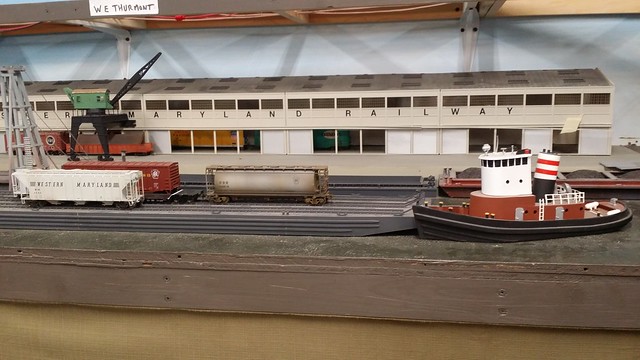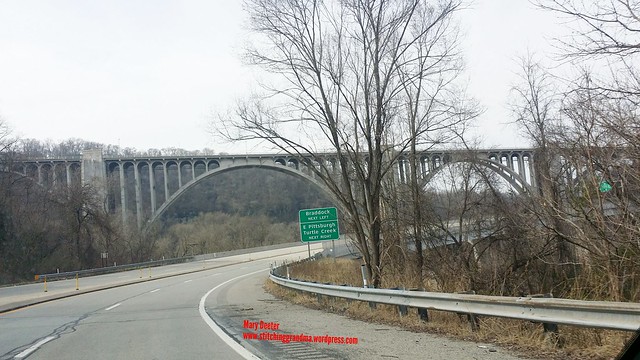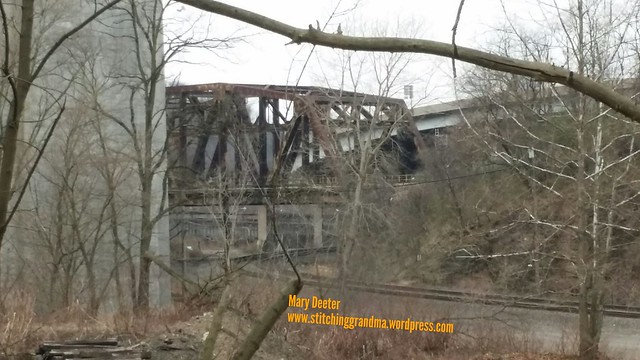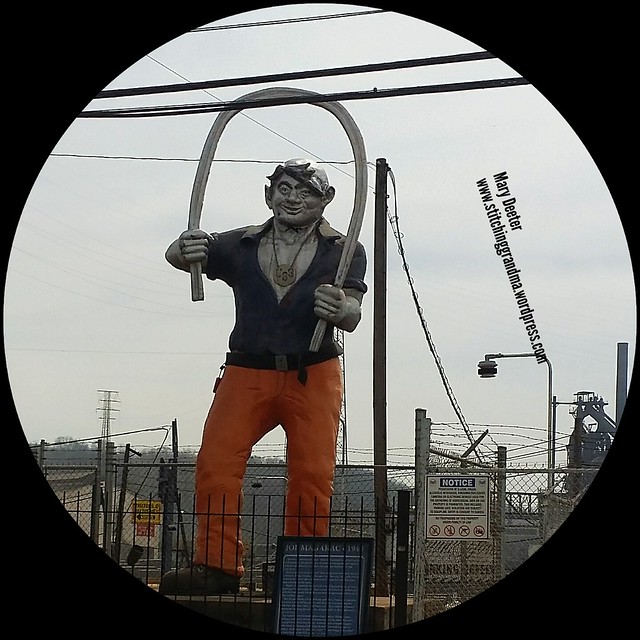I took a road trip with the hubby this past weekend and went to Pittsburgh. My husband was involved in a model railroad gathering and we attended seminars all day on Friday and Saturday. The delight to the model railroad folks in the area is the opportunity to model many railroad lines in the western part of Pennsylvania, and the very real availability to physically “see” what they are planning to model. This group of modelers do “prototypical modeling”, so they want as much “realism and accuracy” as they can get. A lot of the “fun” of modeling in a prototypical fashion is the historical research. Which rail lines went through, what industries they serviced, what commodities were being moved etc. are all factors to consider. Some fellows were modeling from Pittsburgh to the West, while others were modeling Pittsburgh to the east. Some folks considered a geographic area as small as 1 mile, while others spanned hundreds of miles. Throughout the seminars, one thing was readily apparent. These folks take their trains very seriously. Walking around the hotel lobby, you could hear discussions on what type of engine was used during a particular era, which line interchanged where etc. For someone like me with a background in logistics, I am always fascinated about how freight moved before the invention of a C-141, C-5 and C17 aircraft. That is where my area of expertise makes we want to delve further back in time. I understand freight priorities, cargo tonnage and distribution concepts. We had a speaker who fascinated me. Charlie Blenko, was 16 years old, a sophomore in high school, and he spoke with more confidence and poise than almost any of the other presenters. He was researching a short line railroad that had operated not very far from his home over 100 years ago. His use of various tools, such as US Geographic maps, tax maps, and other on line sources from places line Penn State’s library were fascinating. He really put together a presentation that was worthy of a boardroom in a business setting. We attended a presentation by his father also, who introduced himself the next day as “Charlie’s Dad”. You could certainly tell that the apple didn’t fall far from the tree. Charlie’s dad has been building his model railroad at home for the last 15 years. Charlie has become quite the railroad fan in the process. It was nice to see this relationship between father and son over the shared hobby. Charlie’s dad, Andy Blenko, was pretty proud, with good reason.
Part of the RPM Meet (Railroad Prototypical Modelers) involved “operating sessions”. We were included in a group of 11 to “operate” the train layout at a private home in western Pittsburgh, about an hour away from our hotel. I am SO glad we were able to drive over in the daylight. We were up and down, and around and across streams and hills and valleys on 2 lane country roads. I am also very glad that the drive was worth it. We went to operate on James Pinkney’s layout, and he was modeling the Western Maryland RR.
HO Equipment – Western Maryland
I was the “conductor” while my hubby Bill was the engineer. I was a little “less than confidant” operating on a strange layout but all went well. My job was to make sure I was “sorting the cars” into the right industry as we passed through various parts of the train layout. Operating is a bit like a giant game. We pick up the train from the appropriate rail yard. The yardmaster gives you an engine or 2, set up with 20+ rail cars, and the documentation to go with each car.
Rail Yard
The engineer (Bill) contacts the dispatcher for permission to enter the “main line” of the track and proceed to our first stop, where I advise (as the conductor) which cars are to be dropped at the various industries, and which cars are to be picked up from sidings and included in the train for transfer to their next destination. The engineer attempts to do this without tying up the main line, and with the minimum number of switching moves. We proceed with our drops and pickups around the layout, all the while getting direction from the dispatcher. This particular layout had several yards and a helix to help us enter higher or lower levels of the train layout. We ran two trains between 7 pm and 11:30 pm. One was a “local” that had a great deal of switching and was very entertaining. We learned a lot about the layout along the way. And of course, at the end of the run, there was a beer for the conductor! I enjoy this aspect of model railroading and had forgotten how much fun it could be. I haven’t “operated” in a long time, so I was a bit nervous, but it came back to me quickly, especially once I figured out the paperwork, the drop points etc.
Port interchange
Steel Mill
As I mentioned, model railroaders like to depict particular era’s and industries, and this layout was nicely done.
On Sunday, we had a couple of hours to go do a little “rail fanning”. We drove out to a steel mill area and checked out the bridges – both auto and rail, and how everything came together. We had a good time getting off the highways and up and down and in & out of the neighborhoods and back sides of some of the industries. I was enchanted by the George Westinghouse bridge, built between 1929 and 1932, which “George Westinghouse Memorial Bridge in East Pittsburgh, Pennsylvania, carries U.S. Route 30, the Lincoln Highway, over the Turtle Creek Valley near to where it joins the Monongahela River Valley east of Pittsburgh.” (source https://en.wikipedia.org/wiki/George_Westinghouse_Bridge )
Before I arrived at the RPM Meet, I knew very little about the G. Westinghouse bridge. The lecture by “Charlie’s Dad” introduced it to me and I could understand his excitement in modeling the bridge when we drove down to view the area.
Of course, we had to do a little “off highway” driving to see more!
We took a turn just before the bridge and found this road. It was still paved, but grown over. No longer a means to access the bridge, but I bet they were glad of the guard rails when it was in use. We went back up to the main road and took the very NEXT turn and found another road that took us down “under” the bridge. There are 3 rail lines in this photo and one rail bridge, along with the Westinghouse bridge and a more modern bridge on the right. There was a group of about 6 or 8 homes down this road, under the bridge. Those folks “knew someone” who kept fresh asphalt on their road.
That railroad bridge is for the Union Railroad.
Bill wanted to see a little bit of another steel yard, so we headed out from this location, and using our faithful GPS, we found the spot he sought!
Of course, he took lots of photos of the steel mill and I wandered around looking for interesting things. I happened upon Joe Maragac! The story on the blue plaque was quite fanciful.
Joe Magarac is a fictional character, depicting a Croatian steelworker. There are many legends attributed to Joe. I spent this morning learning a bit more about his story, and the fable that depicts him – http://www.croatia.org/crown/articles/9492/1/Joe-Magarac-a-legendary-Croatian-steel-worker-in-the-USA.html . The descriptions on this Croatian website are quite poetic.
On another website, I learned that “Joe Magarac, the story goes, was a man made of steel. He was born in an iron ore mine and raised in a furnace. Some versions of the story said Magarac was seven feet tall. Others claimed he was as tall as a smokestack! His shoulders were as big as the steel-mill door and his hands like the huge buckets (ladles) used to pour molten steel. He ate that hot steel like soup and cold steel ingots like meat.”
source – http://www.jaha.org/edu/discovery_center/work/folk_hero.html .
An article I read from a Penn State website gave a little grimmer part of the tale. It put the reality of the immigrant unskilled labor into a totally different light. The article addresses the issue of fair pay, and working conditions of the steel workers, and takes all the glamour right out of the steel industry. ” Conditions were not exactly comfortable in the mills or the mill towns. Steelworkers were both overworked and underpaid at 15 cents an hour for the average 12 hour day. These wages were considerably below the living wage of the time, $3 per day. Jobs in the steel mill were hot, dangerous, and grueling but immigrants considered it better than no work at all. Not only were conditions uncomfortable, but the jobs were segregated. Prejudice ruled the mills as easier jobs were given to citizens and Northern Europeans, while the most dangerous tasks were assigned to Eastern Europeans.” Source – http://pabook2.libraries.psu.edu/palitmap/JoeMagarac.html
So, for me, the glimmer and gloss of the steel mill is not so shiny. As years have gone by and labor unions struck and demanded safer conditions and fare wages, the industry changed. In Pittsburgh, the decline of the US steel industry is very apparent. There were so many areas we drove around that depicted the living conditions addressed in the article above. Turns out, the steel barons were much like the railroad barons of the 19th century.
Further along we stopped at another point and browsed around about.
This shows a hearth from the “Superintendents Club”. On the left is another bronze plaque that sent me to the wonders of Google this morning!
I wanted to know who this Braddock was and why they named a community for him, and what battle took place in 1755. Turns out it was the French and Indian war, and Braddock was a British officer. George Washington accompanied him in this battle, and survived, where Braddock did not. Braddock’s Defeat as the event was called made quite the impression on George Washington. https://en.wikipedia.org/wiki/Braddock_Expedition . The more I read about General Braddock, the more I realised he was lacking true leadership skills. George Washington penned a letter to his mother, following the death of Braddock and described the defeat in general terms. He tells his mother “I luckily escaped without a wound, though I had four bullets through my coat, and two horses shot under me.” http://www.nationalcenter.org/Braddock’sDefeat.html Other accounts are not nearly as generous to General Braddock. “His rudeness and arrogance made a thoroughly bad impression on the colonials and were to contribute to a jaundiced view of the British officer class.” http://www.historytoday.com/richard-cavendish/general-braddock-defeated
We are still trying to decide why the area was named for this General!
Across the street directly from this monument was another memorial, this one to the US military. Sadly it is in a terrible state of disrepair, which is indicative of the community that surrounds this steel mill.
As I left Pittsburgh, I thought a lot about the human side of industry. This monument in such terrible condition reminds me of the human side of the US Military too, who work those very long shifts, in often poor working conditions; much like the steel workers did. Gratefully the pay is much better, but often not always a living wage for the lowest ranking. I also know why so many people I had contact with in the Air Force over 37 years, had left the rust belt, looking for better lives for themselves and their families, and finding the Air Force offered those opportunities. Some of the folks I knew from the Pittsburgh area were among the hardest working and hardiest people I encountered.
In closing, I want to express that the hobby of model railroading is so much more than a “bunch of men playing with trains”. There is so much history to be learned, along with the logistics of moving freight. It is a great hobby to introduce to a young person, as there are so many directions to make the hobby your own.

















Were you able to do any fabric shopping while you were there?
LikeLike
Hi Susan – not one piece of fabric was purchased. I did have my bag of hexi’s along, but the only time I used a needle and thread was a quick repair to the strap of my favorite pocketbook! It was a total train weekend!
LikeLike
Your hobby sounds fascinating and I’ll have to say you saw parts of Pittsburgh that I never saw when I visited!
LikeLike
Hi Lillian – this was my first visit to the city, and I am not sure any of the places we went were on the “usual” list for a visitor!
LikeLike
I’ve always been fascinated by miniature depictions of real life as one can see in doll houses. That’s why when I had my first tour of Bill’s model railroad club setup last year, you had to drag me away from looking at everything so we could continue our quilting adventure. I am also a history buff. Enjoyed reading about your model railroading adventure. Wonderful that you can enjoy the same hobby that Bill does, though maybe not as intensely.
LikeLiked by 1 person
Gosh, next time you come we will put you to work on scenery at the club!! Glad you found the club interesting along with this post. 😉
LikeLike
Yes, Braddock is a run-down crime-ridden neighborhood of East Pittsburgh, struggling to rebuild. I worked in the city for 28 years traveling all over five counties doing social work. Next time travel 40 minutes more and visit Weirton West Virginia (where I live) and see Weirton Steel and lots of history railroads! ~Ann
LikeLiked by 1 person
Hi Ann — Thanks for taking the time to comment. It was interesting to go across on the Rankin Bridge to Homestead and see the vast urban renewal efforts taking place on a former industrial area called the waterfront. Wonderful bike trails, new housing and shopping looking out over the Monongahela River. There is hope if there are decent jobs. I will have hubby add Weirton WV to his list of places to study & visit. 🙂
LikeLiked by 1 person
Fantastic. We had a very short version of the Soo line a branch of the Canadian Soux Saint Marie come right beside where my house is. The train bridge is still standing behind our yard. I would love to do a toddler sized track piece in our yard, but it just has not come to the top of the priority list. Maybe in a summer or two.
LikeLiked by 1 person
Thanks for the kind comments. Most people who model find themselves modeling a special “time and place”, and that usually means the trains they remember watching from childhood. Good luck with your outdoor train project. G Scale is what is often found in garden projects, and it takes the love of gardening along with the love of trains to make it happen. In your climate, I would think you would want a “siding” that goes off into a “doggie door” in your garden shed to protect the equipment; along with a snow blade on the front of your locomotive!
LikeLiked by 1 person
Oh cute
LikeLiked by 1 person